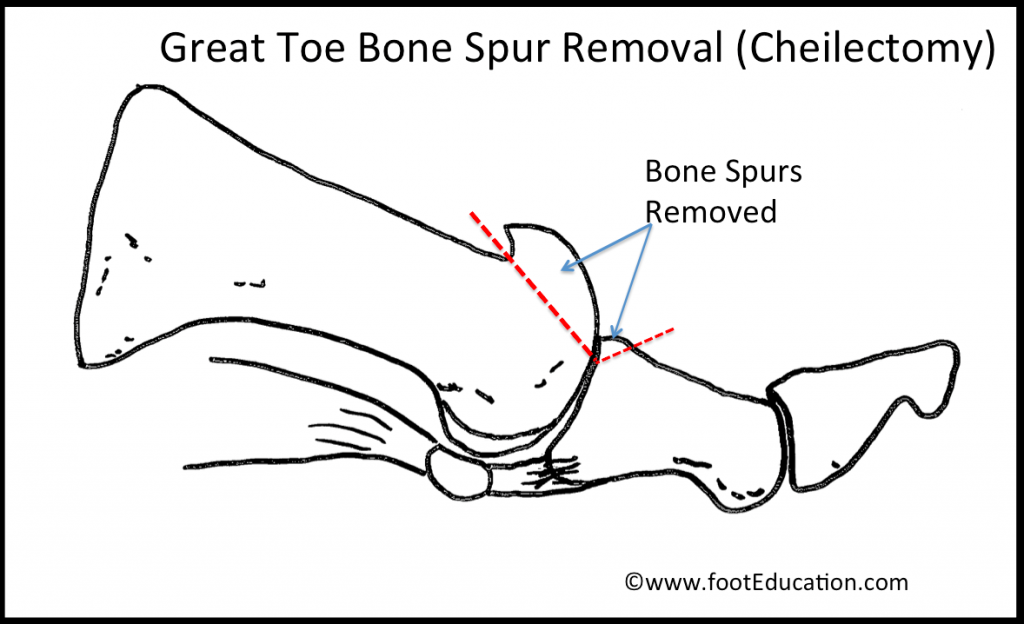1st MTP Cheilectomy
Indications
A cheilectomy involves removal of bone spurs that involve the part of the big toe joint (1st MTP joint). These bone spurs occur as a result of early arthritis of the joint and can cause pain and limited motion of the big toe. The word “cheilectomy” means “the cutting away of a lip of bone.”
This procedure is indicated in those with painful, limited motion of the big toe that does not respond to non-surgical treatment. This is done for pain relief, to allow some improvement in motion through the big toe MTP joint, to decrease shoe wear irritation from the prominence (bump), and to eliminate some early arthritis on the upper surface of the joint. This procedure is effective only for patients who have arthritis involving the top part (dorsal aspect) of the great toe joint (first MTP joint). In all age groups, the bone spur removal is designed to improve mobility of the joint. The cheilectomy procedure is not indicated in patients with extensive arthritis involving the entire joint (more severe or end/late-stage hallux rigidus
Procedure
A cheilectomy does not involve use of metal or other implants. The procedure is performed by making an incision centered over the top of the 1st MTP joint. The tendon that extends the big toe is protected. The cartilage of the joint is inspected. Typically, the top third of the first MTP joint has arthritic changes. This bone spur and arthritic area is removed in order to allow increased motion and improvement in symptoms. The incision is typically about 5-7 cm long, and dissolvable sutures are used to close the incision. A sterile bandage or wrap is used to protect the area after surgery. The procedure is performed as day surgery in almost all cases and can be done under general anaesthetic. Alternatively it may be possible to have the operation performed under a local anaesthetic (an injection above the ankle).
Recovery
Patients are typically able to mobilize with weight bearing as tolerated in a stiff-soled shoe almost immediately after surgery. Instructions for bandage and wound care are given. Some patients prefer to use crutches for a few days after surgery for comfort. Most patients will take a few days off from work in order to have the freedom to elevate the foot frequently to control swelling. Range of motion exercises and occasionally physical therapy are started once the wound has healed. A simple exercise of gently moving the great toe up and down is important to prevent stiffness. Normal walking helps to promote the upward motion, although some patients subconsciously walk temporarily on “the outside border” of the foot to decrease pressure on the big toe. Using a mirror to walk ‘Heel-to-toe’ can help to improve confidence to put normal pressure on the big toe.

Cheilectomy for treatment of mild Hallux Rigidus (arthritis of great toe)
Most patients are able to resume their usual lifestyle within a few weeks, although certain high-intensity activities will not be possible right away. Residual pain and swelling can be expected to limit some activities or even work for about three months post-operatively. Return to intensive sports or demanding physical situations is usually possible by six months.
Driving is not recommended in the 2-4 weeks after surgery, possibly longer in some individuals.
Arthritis symptoms usually resolve about one month after surgery. Patients can experience relief for up to 10 years following the surgery. Actual mobility of the joint varies from patient to patient, but most report a satisfactory improvement, with gains in mobility continuing up to a year after surgery.
Potential Complications
- Progression of arthritis:
There is real potential for a recurrence or persistence of symptoms after a great toe cheilectomy. This can occur relatively quickly if there was more wear and tear in the great toe joint than expected. In addition, this surgery does not fully correct the underlying biomechanical forces that caused the arthritic changes in the first place. Therefore, over time the great toe symptoms may have a tendency to recur. If the symptoms recur, it may be necessary to perform a more definitive procedure, such as a great toe fusion or a 1st MTP joint replacement.
- Local nerve irritation: can occur as a result of this procedure.
- Wound healing problems.
- Infection:
- Blood Clots (DVT):